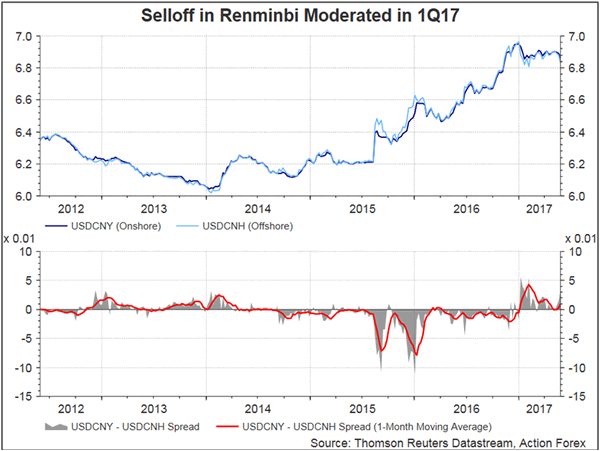The Chinese government has accelerated its step to guide the renminbi higher and the immediate effect is a selloff of USDCNY to the lowest level since January, 2017. Last week, the China Foreign Exchange Trade System (CFETS) confirmed that China’s central bank has added a counter cyclical adjustment factor (CCAF) to the calculation of the USDCNY daily fixing rate. The government indicated that the adjustment factor would help guide market expectations and let the fix reflect more accurately China’s macroeconomic fundamentals. It is appropriate for the move to be introduced in this period of time when the US dollar is weak, as, in our view, the aim of which is to stabilize renminbi, i.e. to prevent it from weakening too much. Given the lack of the details of this adjustment factor, the movement of renminbi is getting more non-transparent, as well as government-driven, rather than market- driven.

In the second half of 2015, China’s the fixing mechanism for renminbi included three main elements, namely, the previous day’s close, overnight movement of the USD against a basket of currencies and “market supply-demand conditions”. The third element, of which the nature was never disclosed, was removed in May 2016 before a counter cyclical adjustment factor (CCAF) was added last week. There lacks details over what the CCAF is other then it would be “dynamically adjusted" to reflect China’s macroeconomic fundamentals and set in a way that helps the fix to better reflect fundamentals. We believe the CCAF is included as the government finds ways to fix its currency higher. Indeed, the CFETS had indicated that the renminbi fixing rate based on the previous formula depreciated although the USD index (DXY) had weakened while China’s economic indicators had improved recently. CFETS suggested that the FX market might have been distorted by herd behavior and irrational expectations.
With timing of introducing this CCAF is also strategic. First, it is when the US dollar has weakened with the DXY index falling to a level not seen since November last year. Lowering USDCNY amidst weakness in US dollar creates a buffer when the greenback strengthens. Domestically, slowdown in capital outflows should help lift expectations on renminbi appreciation. Moreover, the government would prefer to see a stable currency, as well as economic developments, ahead of and during the 19th Party Congress and the subsequent National Peoples’ Congress in March 2018.
A currency subject to more government intervention means it would be less market driven. Furthermore, the government has not disclosed any information about the mechanism of, and criteria in, the adjustment factor. The lack of transparency, together with fact that the government changes its currency basket from time to time, has made estimation of the renminbi movement even more difficult. We believe the move is a setback for the currency’s internationalization progress.















